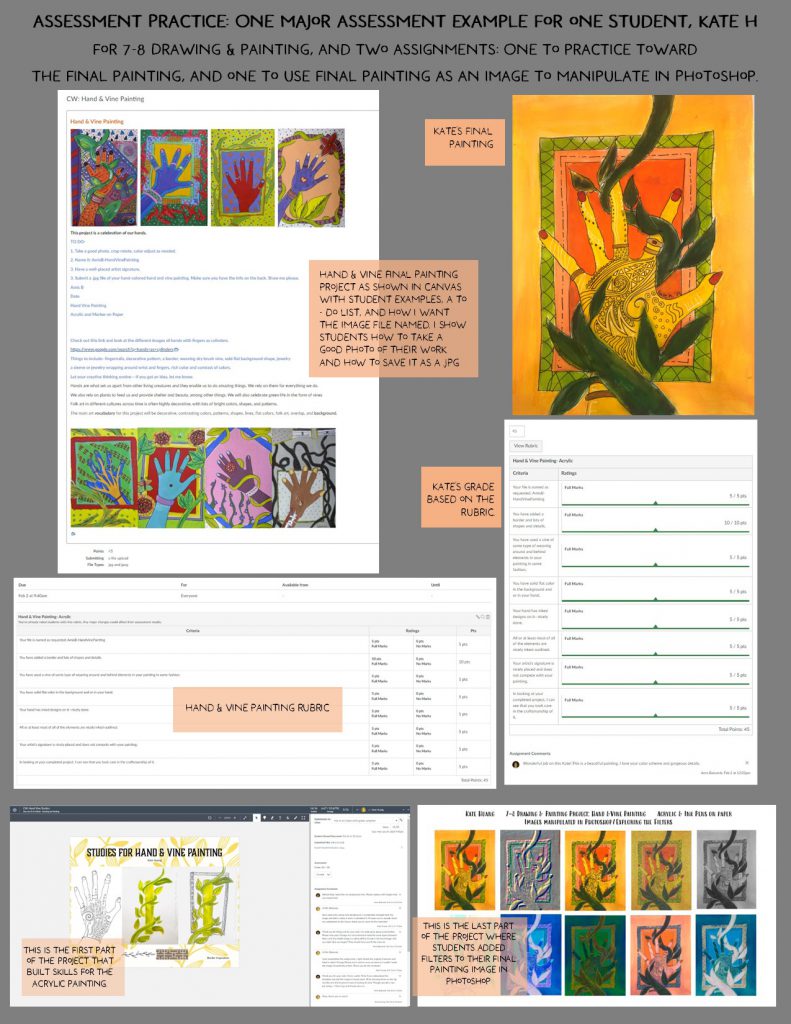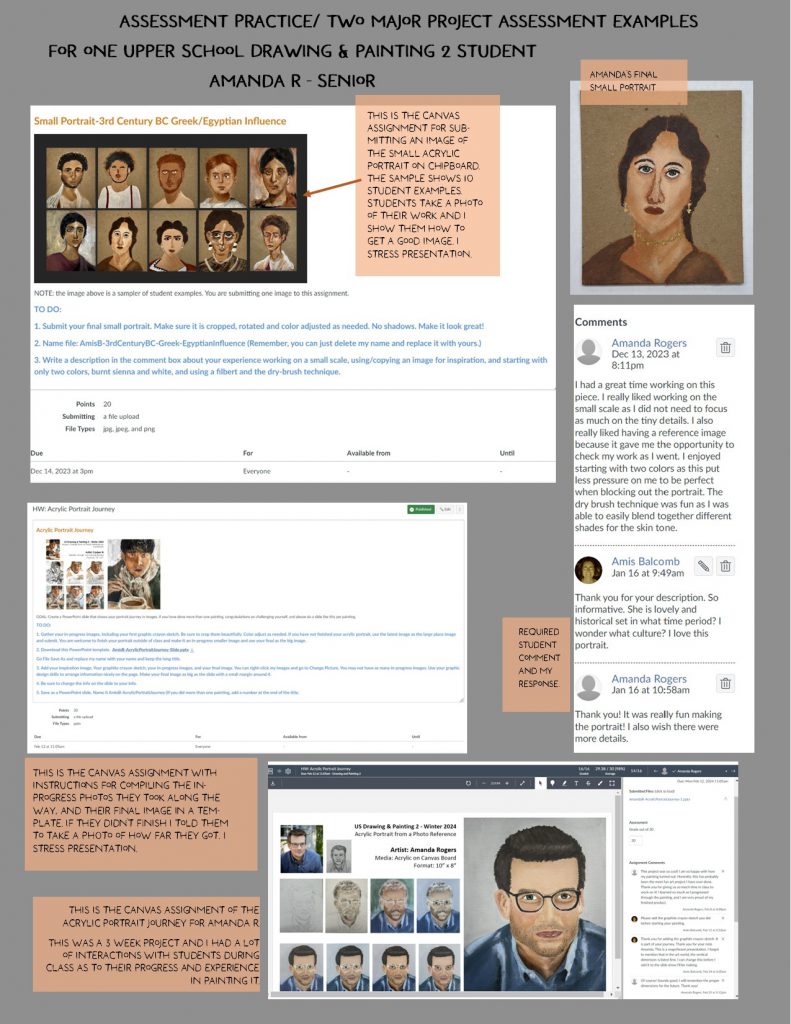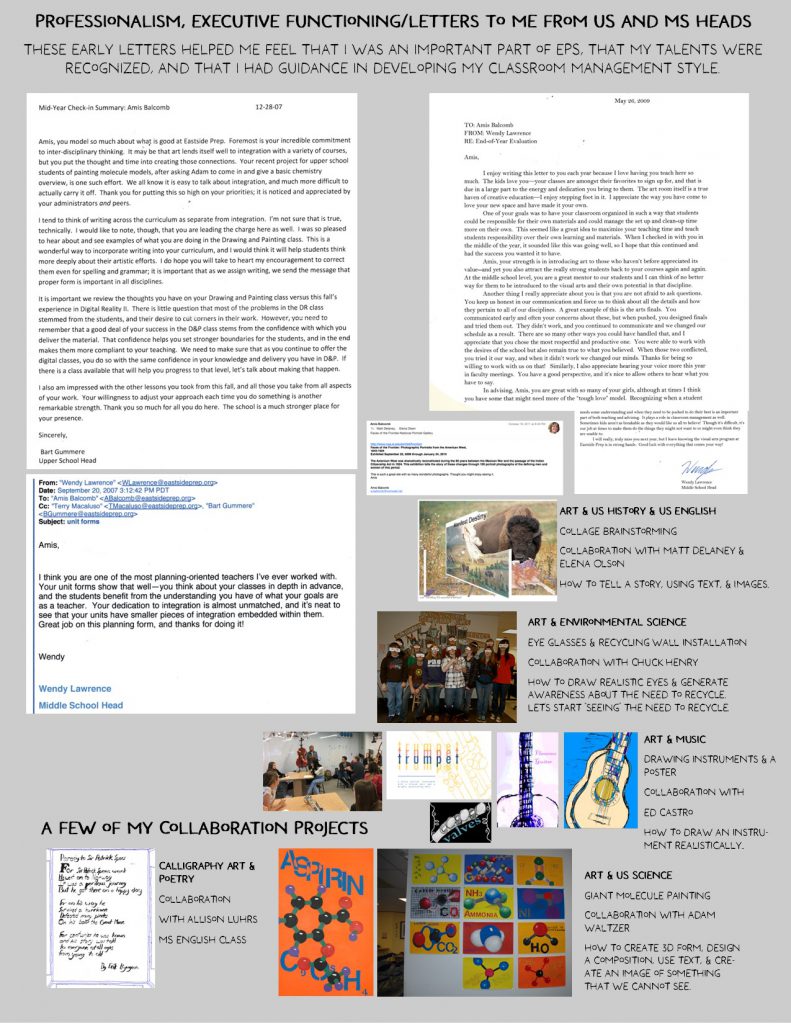Jump to Category: Assessment Practice | Professionalism and Executive Functioning
Assessment Practice
Designs major assessments that reflect course outcomes
- On the Canvas Home pages of each class, I strive to describe the goals and outcomes students can expect to achieve.
- In Canvas, I post in each art project what students will be able to do by participating in each project.
- The mid-term comments, mid-term check form, and the digital portfolio and artist statement are my two major assessments that help me, and the students see and write about what their art experience was.


Designs assignments to be graded and returned in a feedback cycle of seven calendar days
- I make a point and repeat throughout the trimester that communicating with me is the best plan for students if they have been absent, have missed work, and need more time. I am super reasonable in this area.
- Students make a portfolio container that they put their artwork in to take home.
- The challenge of displaying art has always presented problems in being able to return the art. I am continually reviewing how I might improve this process.
- The project/assignments I design start with a complete/incomplete assessment as the grade they earn. You either did it or you did not do it. As the trimester progresses and they become familiar with my style, the criteria as requested in Canvas, and the rhythm of the class, I use a point system with a simple rubric where I request a specific file naming, and criteria for presenting images such as cropping rotating, and color adjusting for the best possible presentation of their art.
- I do not grade their art because each person brings their own background knowledge and daily feelings to class and their work. My role is to encourage the process. That it is in the doing where the skills are developed. And not everything turns out. It’s a personal journey for each student and I do not want to hamper their creative process.
- My critiques are sometimes with a group critique in the upper school level, but I would only do this depending on the group, and I’d only do it once or twice in a trimester. My intention would be to give them the experience of a critique, with a directive to say something positive and one constructive suggestion. Sometimes I show several student examples to show excellence or creative thinking. Sometimes, I project everyone’s art, and I preface it with a look at the cool things we all did, and I don’t give names. Sometimes I ask for everyone to applaud an individual artwork and have an appreciation moment for that particular student.
Ensures the number of assignments in each course is neither excessive nor deficient, providing appropriate time for quality student performance and meaningful teacher feedback.
- Over the years, I have been able to determine how many lessons I can run each trimester based on how long it takes for students to complete a lesson. Every class is different, and I gauge what to add or take out depending on the pace and interest of the class as a group.
- With each trimester, I look in Canvas to see what projects I ran in the previous time I taught the class. I use Canvas in a specific way where I create a new group each trimester and then drag what projects I want to run into the new group/class. I put them in the order I feel like doing them and do as many as possible depending on who the students are in the class and the pacing of the class during the trimester. Sometimes I rearrange the order of the projects, expand a project, add a brand-new project, and/or delete a project. It all depends on the students and what I learn by working with each group. Some groups are super-charged, and I can push them and add things/complexities to a project(s). With some groups, I do fewer well-chosen projects and let them run longer.
- My goal is to add a brand-new lesson each year based on an inspiration I come across or a workshop that I take. It makes it exciting for my own development and to see students respond. Adding something new means that I have to remove a project or incorporate it into an existing project. This process allows me to have a rotating curriculum, and it’s fun to bring back an older lesson that I may not have used for a while.
- My feedback system comprises of verbal feedback, comments I write to the student in the comment box in most assignments, questionnaires that students fill out, a reflection on a project, and an artist summary at the end of the trimester portfolio.
- The live-in-the-moment verbal feedback is given to a student as I walk around the room to see how students are doing and progressing and if they are on track and understanding the instructions. I can tell in an instant if they are understanding by what they are showing and doing with the tools and materials.
Professionalism | Executive Functioning

Approaches recommendations for improvement receptively and responsively
- I feel that I am receptive to feedback and am interested in what others think and experience in visiting my classroom. I listen to suggestions and determine how I can implement them. Or adapt the suggestions in a way that makes sense to the art of teaching art. I am open to suggestions.
- I have met with Jonathan over the years, including this year, to ask him questions about how I might improve on something. This time, it was about using Grammarly and AI regarding comments. I wanted specific help and examples. He showed me different ways to use Grammarly, how it can generate sentences from a few prompts, and what some of the pitfalls can be. I tested it out and determined that I still like my art-specific way of wording, but need and love the editing capabilities, the spell check and typo checking and often apply its suggestions.
Displays openness and comfort with visitors observing class.
- I always welcome anyone to walk through my classrooms at any point. Cheryl and the admissions staff know that they are welcome to bring groups into my classes. I wave them in if the door is closed, and I briefly describe what the class is doing for the visitors.
- I welcome anyone to sit in and observe and or participate.
Seeks out diverse opinions of others for guidance
- On occasion, I will ask guided study hall faculty for ideas with a particular student, or how their experience is in looking at my Canvas pages as they work with an art student.
- When the need arises, I ask other faculty in other disciplines how they do something, for example, if they use seating charts or what systems they have in place.
- Being a team member on Kip’s PDP helped me by being in his classroom multiple times to see how he ran his science classes.
Manages and prioritizes professional tasks and responsibilities.
- I work in Canvas as an organizing tool, which is really helpful.
- Managing the flow of information over Outlook, and my phone for my professional responsibilities is probably my weakest area, where I do ask for help, and this PDP process will hopefully provide me wisdom and guidance.
- I want to get instructions on Outlook to refresh and learn more about how to use it and if I am using it in the most efficient way.
- A goal of mine is that working with my team in my PDP process will help define a better system of organizing my data/materials that will also blend into all aspects of my teaching school life, including professional tasks and responsibilities.
Communicates and responds to students, parents and colleagues in a timely and constructive manner.
- I do try to respond as soon as possible within school hours to students. I might read emails occasionally at night, but I usually don’t respond until the next morning unless it appears urgent. Parents rarely email me so I try to respond as soon as I see their email. I like having a boundary of school hours as a general rule for corresponding with students.
- Responding quickly to student and parent emails, and email from colleagues is important. Each type is different, and each situation requires personalized responses. In my experience as an art teacher, I have not had a lot of correspondence from any of these groups, as I am mostly able to handle issues directly with students in the classroom.